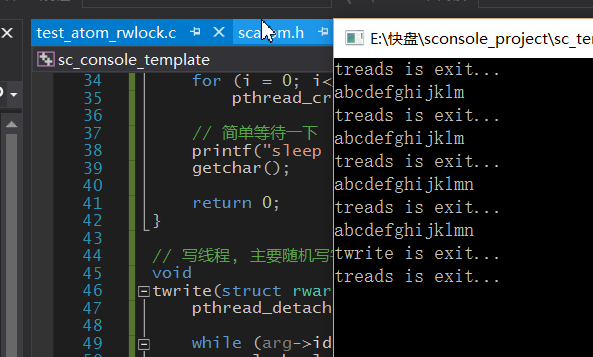引言
读写锁 是为了 解决, 大量 ''读'' 和 少量 ''写'' 的业务而设计的.
读写锁有3个特征:
1.当读写锁是写加锁状态时,在这个锁被解锁之前,所有试图对这个锁加锁的线程都会被阻塞
2.当读写锁在读加锁状态时,再以读模式对它加锁的线程都能得到访问权,但以写模式加锁的线程将会被阻塞
3.当读写锁在读加锁状态时,如果有线程试图以写模式加锁,读写锁通常会阻塞随后的读模式加锁
我们先举一段标准库构建的读写锁demo来了解读写锁api 的使用 .
pthread_rwlock.c
#include <stdio.h> #include <stdlib.h> #include <pthread.h> #define _INT_BZ (13) #define _INT_WTH (2) #define _INT_RTH (10) struct rwarg { pthread_t id; pthread_rwlock_t rwlock; // 加锁用的 int idx; // 指示buf中写到那了 char buf[BUFSIZ]; // 存储临时数据 }; // 写线程, 主要随机写字符进去 void twrite(struct rwarg * arg); // 读线程 void treads(struct rwarg * arg); /* * 主函数测试线程读写逻辑 * 少量写线程, 大量读线程测试 */ int main(int argc, char * argv[]) { // 初始化定义需要使用的量. C99以上写法, 避免跨平台不同实现的警告问题, 感谢好人随性徜徉 struct rwarg arg = { 0, .rwlock = PTHREAD_RWLOCK_INITIALIZER, 0, "" }; int i; // 读线程跑起来 for(i=0; i<_INT_RTH; ++i) pthread_create((pthread_t *)&arg, NULL, (void * (*)(void *))treads, &arg); // 写线程再跑起来 for(i=0; i<_INT_WTH; ++i) pthread_create((pthread_t *)&arg, NULL, (void * (*)(void *))twrite, &arg); // 简单等待一下 printf("sleep input enter:"); getchar(); return 0; } // 写线程, 主要随机写字符进去 void twrite(struct rwarg * arg) { pthread_detach(pthread_self()); pthread_rwlock_wrlock(&arg->rwlock); while(arg->idx < _INT_BZ) { arg->buf[arg->idx] = 'a' + arg->idx; ++arg->idx; } pthread_rwlock_unlock(&arg->rwlock); } // 读线程 void treads(struct rwarg * arg) { pthread_detach(pthread_self()); while(arg->idx < _INT_BZ) { pthread_rwlock_rdlock(&arg->rwlock); puts(arg->buf); pthread_rwlock_unlock(&arg->rwlock); } }
编译
gcc -Wall -ggdb2 -o pthread_rwlock.out pthread_rwlock.c -lpthread
执行的结果

linux上执行没反应, 这代码放在window 同样没有反应. 主要原因是 大量读加锁阻塞了写加锁.
预估主要原因是 pthread 实现的 rwlock 读写锁, 没有粗暴支持读写锁特性3 . 这也是其读写锁一个潜在bug(写锁没有阻塞后续的读锁).
是不是有些收获, 底层API有问题也不少的. 哈哈.
这里扯一点C基础语法 中 I 对于 美得 感受与写法. 希望大家有思考.
a) 指针一般 写法
int *piyo; // 声明部分 int *heoo(int a, int *pi); // 定义部分 int * heoo(int a, int b) { ... }
上面是一种通用写法. 缺点在 声明和 定义 不统一, 不协调, 不爽.
b) 指针仿照OOP 写法
int* piyo; // 声明部分 int* heoo(int a, int* pi); //定义部分 int* heoo(int a, int b){ ... }
这种写法很好理解, 也很好看. 可惜这是C, (C++也是). 因为C出现比较早, 存在缺陷. 上面致命缺点是
int* piyo, *hoge;
特别丑.
c) 请用下面写法, 都是从无数别人代码中磨出来的.
int * piyo; // 声明部分 int * heoo(int a, int * pi); //定义部分 int * heoo(int a, int b){ ... }
到这里扯淡结束了. 编程 希望是 实用->设计好->有美感->自然 . 而不是 屎一样的实现而妄想优雅的接口. 如果有一天能为自己写代码的话.
前言
到这里我们按照上面读写锁的3条特性, 自己实现一个读写锁. 首先看数据结构
// init need 0 struct rwlock { int rlock; int wlock; };
当我们需要使用读写锁时候只需要 struct rwlock lock = { 0 , 0 }; 很清洁
后面先在linux 使用gcc 提供的原子操作特性实现一个 读锁 实现
// 加读锁 static void rwlock_rlock(struct rwlock * lock) { for(;;) { // 看是否有人在试图读, 得到并防止代码位置优化 while(lock->wlock) __sync_synchronize(); __sync_add_and_fetch(&lock->rlock, 1); // 没有写占用, 开始读了 if(!lock->wlock) break; // 还是有写, 删掉添加的读 __sync_add_and_fetch(&lock->rlock, -1); } }
在加写锁时候, 先判断读锁是否没有人在使用了. __sync_synchronize 是为了防止进行代码位置优化. 后面逻辑是
开始加读锁, 但是在加读锁瞬间如果有写锁那么立马释放刚申请的读锁. 一切为读锁为核心设计.
对于写锁
// 加写锁 static void rwlock_wlock(struct rwlock * lock) { while(__sync_lock_test_and_set(&lock->wlock, 1)) ; // 等待读占用锁 while(lock->rlock) __sync_synchronize(); }
只考虑读锁互相竞争, 竞争好了之后, 开始等待读锁. 好理解, 后面释放相对容易. 扯一点对于pthread标准库读写锁只有一个释放接口. 估计内存有状态保持. 才能保证释放.
使用方便, 但是性能不好. 读写锁实现耦合又大了. 这里实现
// 解写锁 static inline void rwlock_wunlock(struct rwlock * lock) { __sync_lock_release(&lock->wlock); } // 解读锁 static inline void rwlock_runlock(struct rwlock * lock) { __sync_add_and_fetch(&lock->rlock, -1); }
写锁 直接解锁到底, 读锁采用引用减少一处理. 看一个demo simple_rwlock.c

#include <stdio.h> #include <stdlib.h> #include <pthread.h> // init need 0 struct rwlock { int rlock; int wlock; }; // 加读锁 static void rwlock_rlock(struct rwlock * lock) { for(;;) { // 看是否有人在试图读, 得到并防止代码位置优化 while(lock->wlock) __sync_synchronize(); __sync_add_and_fetch(&lock->rlock, 1); // 没有写占用, 开始读了 if(!lock->wlock) break; // 还是有写, 删掉添加的读 __sync_add_and_fetch(&lock->rlock, -1); } } // 加写锁 static void rwlock_wlock(struct rwlock * lock) { while(__sync_lock_test_and_set(&lock->wlock, 1)) ; // 等待读占用锁 while(lock->rlock) __sync_synchronize(); } // 解写锁 static inline void rwlock_wunlock(struct rwlock * lock) { __sync_lock_release(&lock->wlock); } // 解读锁 static inline void rwlock_runlock(struct rwlock * lock) { __sync_add_and_fetch(&lock->rlock, -1); } // ------------------------ 下面是业务代码 ---------------------------------- #define _INT_BZ (13) #define _INT_WTH (2) #define _INT_RTH (10) struct rwarg { pthread_t id; struct rwlock lock; // 加锁用的 int idx; // 指示buf中写道那了 char buf[BUFSIZ]; // 存储临时数据 }; // 写线程, 主要随机写字符进去 void twrite(struct rwarg * arg); // 读线程 void treads(struct rwarg * arg); /* * 自己写读写锁底层 */ int main(int argc, char * argv[]) { // 初始化定义需要使用的量 struct rwarg arg = { 0 }; int i; // 读线程跑起来 for(i=0; i<_INT_RTH; ++i) pthread_create((pthread_t *)&arg, NULL, (void * (*)(void *))treads, &arg); // 写线程再跑起来 for(i=0; i<_INT_WTH; ++i) pthread_create((pthread_t *)&arg, NULL, (void * (*)(void *))twrite, &arg); // 简单等待一下 printf("sleep input enter:"); getchar(); return 0; } // 写线程, 主要随机写字符进去 void twrite(struct rwarg * arg) { pthread_detach(pthread_self()); while(arg->idx < _INT_BZ) { rwlock_wlock(&arg->lock); arg->buf[arg->idx] = 'a' + arg->idx; ++arg->idx; rwlock_wunlock(&arg->lock); } puts("twrite is exit..."); } // 读线程 void treads(struct rwarg * arg) { pthread_detach(pthread_self()); while(arg->idx < _INT_BZ) { rwlock_rlock(&arg->lock); puts(arg->buf); rwlock_runlock(&arg->lock); } puts("treads is exit..."); }
代码就是上面读写锁实现加上上面例子构建的. 编译命令
gcc -Wall -ggdb2 -o simple_rwlock.out simple_rwlock.out -lpthread
执行结果

得到我们想要的结果, 说明这个读写锁至少满足了业务, 比pthread 好用并且功能完整. 后面再看正文扩展成通用库.
正文
到这里前戏都已经快完毕, 需要到正文了. 通过上面细说, 我们能够封装一个跨平台的读写锁了. 看 scatom.c
#ifndef _H_SIMPLEC_SCATOM #define _H_SIMPLEC_SCATOM /* * 作者 : wz * * 描述 : 简单的原子操作,目前只考虑 VS(CL) 小端机 和 gcc * 推荐用 posix 线程库 */ // 如果 是 VS 编译器 #if defined(_MSC_VER) #include <Windows.h> //忽略 warning C4047: “==”:“void *”与“LONG”的间接级别不同 #pragma warning(disable:4047) // v 和 a 都是 long 这样数据 #define ATOM_FETCH_ADD(v, a) InterlockedExchangeAdd((LONG volatile *)&(v), (LONG)(a)) #define ATOM_ADD_FETCH(v, a) InterlockedAdd((LONG volatile *)&(v), (LONG)(a)) #define ATOM_SET(v, a) InterlockedExchange((LONG volatile *)&(v), (LONG)(a)) #define ATOM_CMP(v, c, a) (c == InterlockedCompareExchange((LONG volatile *)&(v), (LONG)(a), (LONG)c)) /* *对于 InterlockedCompareExchange(v, c, a) 等价于下面 *long tmp = v ; v == a ? v = c : ; return tmp; * *咱们的 ATOM_FETCH_CMP(v, c, a) 等价于下面 *long tmp = v ; v == c ? v = a : ; return tmp; */ #define ATOM_FETCH_CMP(v, c, a) InterlockedCompareExchange((LONG volatile *)&(v), (LONG)(a), (LONG)c) #define ATOM_LOCK(v) while(ATOM_SET(v, 1)) Sleep(0) #define ATOM_UNLOCK(v) ATOM_SET(v, 0) // 保证代码不乱序优化后执行 #define ATOM_SYNC() MemoryBarrier() // 否则 如果是 gcc 编译器 #elif defined(__GNUC__) #include <unistd.h> /* * type tmp = v ; v += a ; return tmp ; * type 可以是 8,16,32,64 bit的类型 */ #define ATOM_FETCH_ADD(v, a) __sync_fetch_add_add(&(v), (a)) /* * v += a ; return v; */ #define ATOM_ADD_FETCH(v, a) __sync_add_and_fetch(&(v), (a)) /* * type tmp = v ; v = a; return tmp; */ #define ATOM_SET(v, a) __sync_lock_test_and_set(&(v), (a)) /* * bool b = v == c; b ? v=a : ; return b; */ #define ATOM_CMP(v, c, a) __sync_bool_compare_and_swap(&(v), (c), (a)) /* * type tmp = v ; v == c ? v = a : ; return v; */ #define ATOM_FETCH_CMP(v, c, a) __sync_val_compare_and_swap(&(v), (c), (a)) /* *加锁等待,知道 ATOM_SET 返回合适的值 *_INT_USLEEP 是操作系统等待纳秒数,可以优化,看具体操作系统 * *使用方式 * int lock = 0; * ATOM_LOCK(lock); * * // to do think ... * * ATOM_UNLOCK(lock); * */ #define _INT_USLEEP_LOCK (2) #define ATOM_LOCK(v) while(ATOM_SET(v, 1)) usleep(_INT_USLEEP_LOCK) // 对ATOM_LOCK 解锁, 当然 直接调用相当于 v = 0; #define ATOM_UNLOCK(v) __sync_lock_release(&(v)) // 保证代码不乱序 #define ATOM_SYNC() __sync_synchronize() #endif // !_MSC_VER && !__GNUC__ #ifndef _STRUCT_RWLOCK #define _STRUCT_RWLOCK /* * 这里构建simple write and read lock * struct rwlock need zero. */ // init need all is 0 struct rwlock { int rlock; int wlock; }; // add read lock static void rwlock_rlock(struct rwlock * lock) { for (;;) { // 看是否有人在试图读, 得到并防止代码位置优化 while (lock->wlock) ATOM_SYNC(); ATOM_ADD_FETCH(lock->rlock, 1); // 没有写占用, 开始读了 if (!lock->wlock) break; // 还是有写, 删掉添加的读 ATOM_ADD_FETCH(lock->rlock, -1); } } // add write lock static void rwlock_wlock(struct rwlock * lock) { ATOM_LOCK(lock->wlock); // 等待读占用锁 while (lock->rlock) ATOM_SYNC(); } // unlock write static inline void rwlock_wunlock(struct rwlock * lock) { ATOM_UNLOCK(lock->wlock); } // unlock read static inline void rwlock_runlock(struct rwlock * lock) { ATOM_ADD_FETCH(lock->rlock, -1); } #endif // !_STRUCT_RWLOCK #endif // !_H_SIMPLEC_SCATOM
我们是可以直接在window上测试, 对于window上线程模型同样采用 pthread for win32.
测试文件 sc_template/sc_console_template/main/test_atom_rwlock.c
#include <stdio.h> #include <scatom.h> #include <pthread.h> #define _INT_BZ (13) #define _INT_WTH (2) #define _INT_RTH (10) struct rwarg { pthread_t id; struct rwlock lock; // 加锁用的 int idx; // 指示buf中写道那了 char buf[BUFSIZ]; // 存储临时数据 }; // 写线程, 主要随机写字符进去 void twrite(struct rwarg * arg); // 读线程 void treads(struct rwarg * arg); /* * 自己写读写锁底层 */ int main(int argc, char * argv[]) { // 初始化定义需要使用的量 int i; struct rwarg arg = { 0 }; // 读线程跑起来 for (i = 0; i<_INT_RTH; ++i) pthread_create((pthread_t *)&arg, NULL, (void * (*)(void *))treads, &arg); // 写线程再跑起来 for (i = 0; i<_INT_WTH; ++i) pthread_create((pthread_t *)&arg, NULL, (void * (*)(void *))twrite, &arg); // 简单等待一下 printf("sleep input enter:"); getchar(); return 0; } // 写线程, 主要随机写字符进去 void twrite(struct rwarg * arg) { pthread_detach(pthread_self()); while (arg->idx < _INT_BZ) { rwlock_wlock(&arg->lock); arg->buf[arg->idx] = 'a' + arg->idx; ++arg->idx; rwlock_wunlock(&arg->lock); } puts("twrite is exit..."); } // 读线程 void treads(struct rwarg * arg) { pthread_detach(pthread_self()); while (arg->idx < _INT_BZ) { rwlock_rlock(&arg->lock); puts(arg->buf); rwlock_runlock(&arg->lock); } puts("treads is exit..."); }
F7 -> Ctrl + F5 运行结果

一切正常. 后面将代码放入linux 上测试一下. 先看下面目录结构

编译命令
gcc -Wall -ggdb2 -I. -o test_atom_rwlock.out test_atom_rwlock.c -lpthread
执行结果 也是一切正常

这里 -I是为了附加指定的查找路径, -ggdb2 启用宏调试等级. 代码中存在 struct rwarg arg = { 0 };
其实使用了C初始化特性, 标注的按照标注的初始化, 未标注的直接按照零初始化.
后记
错误是难免欢迎吐糙~~ (● ̄(エ) ̄●)
烂泥 http://music.163.com/#/song?id=411314656

